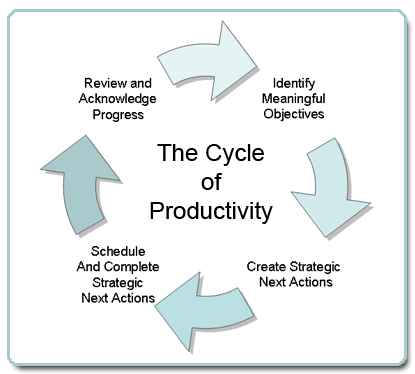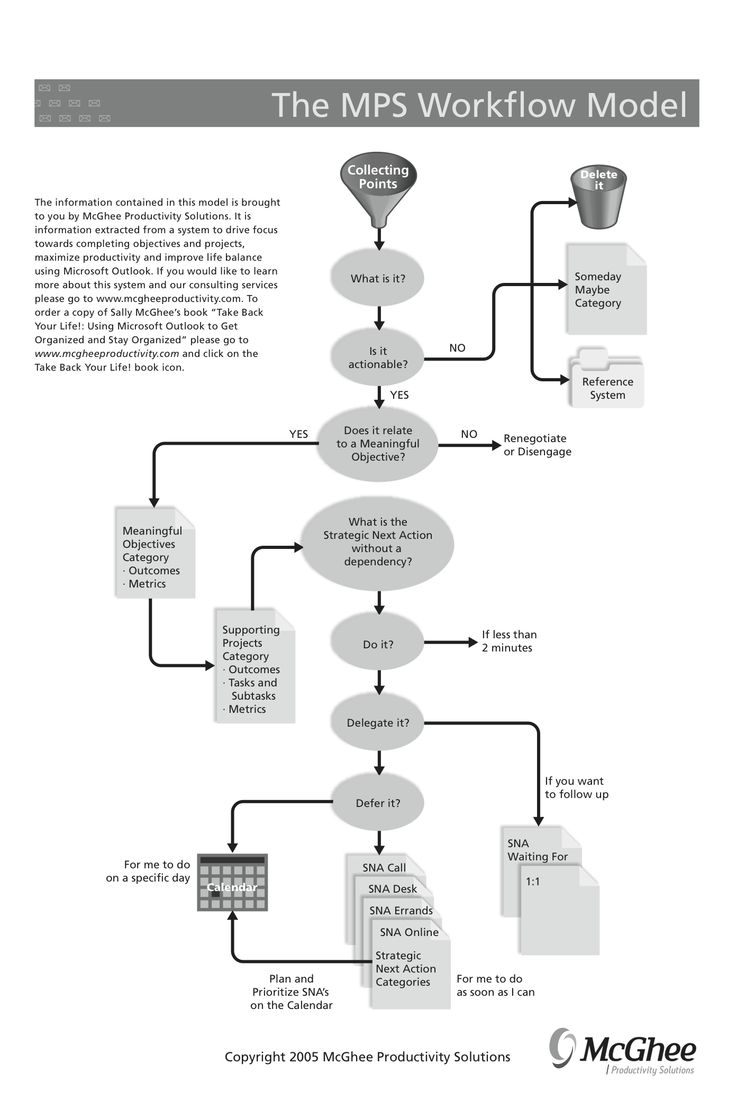Take Back Your Life
by Sally McGhee
A primer for AuthorDock
The cycle:

Step 1 - Identify meaningful objectives
A clear objective that is also meaningful (for motivation/discipline) allows you to monitor progress, correct course, and maintain focus on tasks that move you closer to completing the objective.
It’s the filter to weed out the relevant from the irrelevant. The only thing that is relevant is that which helps you complete your prime objective.
If you feel like a misguided missile when you start your day, it’s likely because you lack a clear prime objective. This is why strategic planning is key at the start (which you can build in your AuthorDock). It’s when you start putting activities on your punchlist that don’t tie to a meaningful objective that the punchlist begins to stall.
Step 2 - Create Strategic Next Actions (SNAs on the Punchlist)
Create events that move you closer to the completion of your punchlist item. The checklist within AuthorDock is helpful, and what’s important is that they are small tasks that can be completed and that the prerequisite to complete them are also part of the checklist. For example, we need to sell a table. But the event I would create to sell the table is to first schedule time to create a craigslist add. Within that event, I identify everything that needs to be done to complete it - such as taking a picture of the table, measuring the table, etc...
This is actually an important concept to really grasp. An example right now is the LED clipboard I desire to create (I really want one for myself and suspect there are many other people who would be interested as well). What are the steps? As long as I am making forward progress, it will happen. I need to identify the prerequisites and complete them one by one.
Personal power is when this starts to be taken into consideration in your conversations and commitments to others.
Step 3 - Schedule and complete SNAs (Punchlist)
Deadlines drive action
The majority of the issue stems with stuffing too much to do into one day. Unrealistic expectations of the time it takes, and not letting your schedule be your guidepost. A punchlist item with out a deadline or resource assigned is just a someday/maybe item. Or a ‘Could’ or ‘Should’ event. Once it’s assigned a ‘Must’ - it’s on a deadline. The priorities you assign are what define the order in your AuthorDock ‘My Page’ view: http://authordock.com/my/page
It does look like when a client assigns a task to me, depending on the deadline date, it will pop to the top of the list!
Integrated Management System (IMS)
At the heart of your productivity lies the IMS. AuthorDock maintains all the information relevant to your work in one centralized location. Most importantly, it can be shared with your team and scaled to address the ever expanding scope of your work.
At the heart of AuthorDock is the punchlist, a set of tasks tied to your prime objective. It allows you and your team to address the incomplete and see the workflow behind you. It allows you to continually refine and repeat best practices which is the key to success. Lose a team member? No problem, with AuthorDock, all the history is available for the new person to pick up the ball and travel the worn path.
Included in your annual subscription is a guide to setting up your own dock and initial consultation. I have had many clients report it’s worth the entry fee alone because it helps them establish greater clarity and identify meaningful relevant goals tied to their desired outcome.
Users thrive on AuthorDock when they define these 3 disciplines:
- Collection Filter
- Reference information
- Action system
Collection Filter (incoming)
Collection points for your communication and promised actions. It’s where you capture (and assign) tasks, jot down reminders, maintain reference info.
Reference Information (War Rooms)
This is quick access to information you may need to achieve your tasks. Checklists, procedures, metadata, and more. The key is having a system you can search quickly and putting some thought into the hierarchy of your ‘virtual filing system’ is very helpful.
Action System (the punchlist)
At the heart of AuthorDock is the punchlist. A punchlist is the central list of actions identified to achieve your prime objective (meaningful objectives and outcomes).
The main components of the system
- Meaningful objectives
- Supporting Projects
- 1:1 meetings
- Strategic Next Actions
Decision
Pause. You need to make rapid decisions, but it’s in the pauses that effective decisions are made. Nothing is more damaging than allocating time for a tasks not aligned with your prime objective. This is probably why I have so many unfinished projects! Get started today practicing tell clients: “I’m sorry, but it’s not my prime objective right now.” (OK, I need to come up with a better way to say it).
This is the classic go/no go decision and the entire crux of the wireframe concept! The diagram below is an example of a wireframe:

It’s the decisions we make upstream that image where we go downstream.
When you are in a mode of reacting to everything that arrives, you quickly find yourself spread too thin and only have yourself to blame when your raft ends up going over the waterfall.
Built into each ‘new event’ is the workflow to help you make a swift decision:
Is it Actionable?
NO: 1. Delete it. 2. Move it to the war room ‘Someday Maybe’ or ‘NOT NOW’ folder or the ‘Metadata’ page if it’s information you will likely need to refer to in the future.
YES: Ask: Does it support your prime objective? If not, politely disengage or refer it to a partner. If it does support a prime objective, then: 1. Define the outcome, required resources, and measure of completion. 2. Define Strategic Next Action (SNA) - remember, it needs to be an action that doesn’t have a dependency on something else.
If it meets this criteria, then you truly only have 4 options:
- Do it now
- Do it later (schedule now or put on your ‘stuff to schedule’ task)
- Delegate it
- Reject (if you determine there is indeed a dependency you didn’t see before)
Diving into each:
Do it Now
Things you can do in 10 minutes or less.
Do it later (i.e. Defer It)
Longer than 10 minute tasks need to be put on your schedule! These items will be reviewed on a daily basis as you define the SNAs. You will assign contexts to batch and define the most appropriate time and place.
Delegate it
In AuthorDock, you assign to a member of your team. Key is to define some ‘check in’ times which can be scheduled events to follow-up. A big issue you will struggle with is that the majority of other people are horribly organized as well, meaning they are in reactive mode and it’s very likely the request will fall off their radar.
Reject
As you start to dive into the details of a task, you determine there are dependencies. Reject the task and work on the first non-dependent task you can determine (which may be as simple as determining that you need to do more analysis).